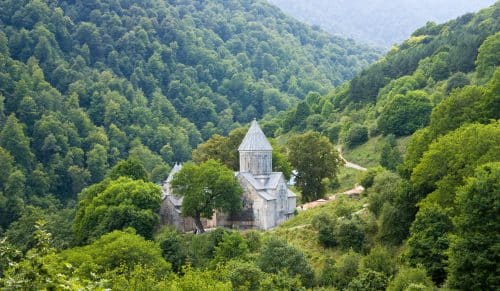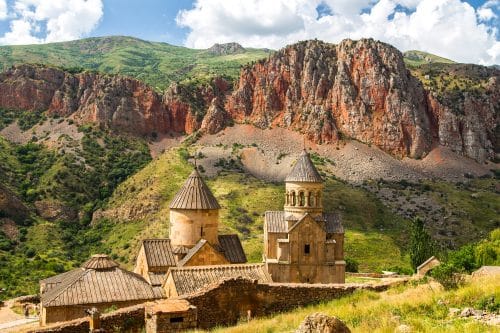Armenia is living history. Ancient churches and monasteries sit alongside bustling cities and varied landscapes, drawing visitors out of their comfort zone and into the past. From the hot springs and forested valleys of Jermuk to the ancient cave dwellings of Khndzoresk, there are so many wonderful places to factor into your itinerary.
If you want to travel to Armenia, this ultimate guide will help you to get the best out of its cities, rural landscapes and incredible history.
Main Cities in Armenia
You will find the best of Armenia’s food and live music scene in the streets of its cities. Whether you want to wander through the sprawling capital or lose yourself in ancient alleyways, these are the places you should aim to include.
Yerevan
Upon arrival in Armenia, you will be greeted by the winding streets of the capital city. Yerevan is alive with contradictions – modern wine bars sit alongside traditional teahouses and the narrow streets are lined with food stalls and… The leafy and much loved Republic Square is the heart of the city and on warm evenings the locals gather there to enjoy cups of strong coffee and listen to live music. Throughout the summer months, the fountains on the square are the center of a nightly performance. Their water jets are combined with a colorful light show and live music and the show draws locals and visitors alike from across the city.

Alongside the main square and its surrounding boulevards, visitors should make time to visit Vernissage, the best flea market in the city, and to take in an opera or dance performance at the historic theatre. Alternatively, if you really want to live like a local, hop between cafes on Northern Avenue or take a picnic lunch to the Cascade; a giant stairway which offers wonderful views of Mount Ararat.
Jermuk
Down in the Southern part of the country, surrounded by mountain peaks and alpine lakes, is the charming town of Jermuk. For years, visitors have flocked here from across Armenia to soak themselves in the city’s hot-springs which are widely reported to have curative properties. If you look a little wider, you’ll find densely forested surroundings which are dotted with crystalline pools. These are also perfect for bathing in and are tied together with well-signposted hiking trails which lead to and from the town.
One of the town’s most famous and picturesque landmarks is the Jermuk Waterfall. Towering at over 70 meters, it is the second highest waterfall in the country and can be reached on foot from the center of town in a couple of hours. With plenty of other hiking trails also waiting to be discovered, Jermuk is the perfect place to get away from the hustle and bustle of Armenia’s larger cities.
Dvin
Although now only a village, Dvin makes the list because it is the site of one of the greatest archaeological marvels in the whole of Armenia. An ancient city, also named Dvin, was unearthed in 1958 and has evidence of human civilization back to 3000 BC. Early Medieval written sources also list Dvin as the capital of Armenia but it was reportedly ransacked by the Mongols in 1236. Little now remains of the city but it is possible to take a tour around the ruins with a local guide and learn about the fascinating history of the settlement.
The Great Outdoors in Armenia
Often overshadowed by its neighbor Georgia, Armenia is also home to some of the most pristine and wonderful alpine scenery in Europe. From carpets of wildflowers to towering mountain peaks, its diversity alone is enough to draw in lovers of the great outdoors.
Dilijan National Park
Tucked away in the north of the country, Dilijan National Park is known for its deeply forested landscapes and natural hot springs. Whether you want a half day to wander or a multi-day trek, its well-signposted trails will show you some of Armenia’s most stunning natural wonders. Those short on time should consider visiting Clear Lake. Seven kilometers from the town of Dilijan, it is possible to travel through the forest on foot or to drive along a dirt track and park at the lakeside. From there, a 2-hour trek will take you to Goshavank Monastery or you can rent a boat at the lake and take some time to unwind.

Lake Sevan
The largest lake in the Caucasus, Lake Sevan is one of the most picture perfect locations in Armenia. Its waters change color with the weather, ranging from dazzling azure to midnight blue and everything in between. Sevanavank Monastery stands on its shorelines, overlooking the waters and drawing visitors from far and wide. It dates back to the 9th Century and is a beautifully preserved testament to ancient Armenian architecture and culture. You can easily spend a few days at Sevan, taking a dip in the lake, trying out adventure sports and sampling local fish delicacies. You should also take some time to explore the lake’s broader surroundings, especially Noratus Cemetery, which is home to the largest collection of carved memorial stones in the world, and Hayravank Monastery – a 10th Century church overlooking nearby mountains.
Shikahogh State Reserve
Home to lush vegetation, babbling brooks and rugged cliffs, Shikahogh is one of Armenia’s most biodiverse reserves. Located in the south of the country, its remote location means that it does not attract many visitors and is perfect for travelers seeking an off the beaten track experience. Its trails are less well signposted than those in the other parks so it is best to purchase a local map before you head into the reserve and to keep an eye out for landmarks.
The History
Armenia is alive with history. Ancient churches and monasteries sit alongside cave settlements and silk road passing points, all painting a rich picture of the country’s long and illustrious cultural history. Having diligently and proudly preserved their heritage over thousands of years, Armenia now offers one of the most complete and thorough insights into a long forgotten ancient world.
Old Khndzoresk Cave Village
Deep in the mountains of eastern Armenia, you will find the cave village of Old Khndzoresk. Estimates suggest that over 15,000 people once lived within its cave networks and at the end of the 19th Century it was still the largest village in the east of the country. Today it is home to little more than local livestock which grazes along the landscape and is connected to New Khndzoresk, the modern village, by a 160-meter long suspension bridge. While crossing the gorge is not for the faint-hearted, those who brave it will be rewarded with an insight into Armenia’s rural history and the thriving community which lived among Khndzoresk’s ancient walls.
Noravank Monastery
The beautifully preserved Noravank Monastery, built in the 13th Century in one of Armenia’s loveliest valleys, is a must-see for all visitors. While many of the monasteries and churches in the area were ransacked during the Mongol invasion, Noravank’s intricate stonework and ornate frescos have managed to stand the test of time. Locals believe that the reason for this was one particular representation of God himself, built over the main doorway, depicted with large almond-shaped eyes. The story goes that upon seeing the relief drawn with phenotypically Asiatic features, the mirror of their own, the Mongols were moved to leave Noravank untouched.

Geghard Monastery
Geghard dates back to the fourth century and, despite falling victim to invading forces over the years, is still standing proudly. Named after the lance that pierced Christ’s side at the crucifixion, it is now an important pilgrimage site which draws holy visitors from all over the world. One of the best experiences on offer at Geghard lies in the monastery’s interconnected rock chapels. If you time your visit correctly, you will be able to hear traditional choral throat singing. The ethereal sound reverberates off the surrounding walls and fills every crevice with its vibrations. It’s an unforgettable experience and one that has been enjoyed by passing visitors for thousands of years.
Areni Caves
First excavated in 2007, and continuing to offer archaeological finds to this day, Areni has been a real cave of wonders for historians of the Copper Age. The complex is home to a series of burial sites, dating back as far as 6000 BC, which offer a fascinating insight into the role of ritual in ancient civilization. One of the caves even yielded an ancient wine press, cementing Armenia’s status as the oldest winemaking nation in the world. Tours of the caves are available, led by local historians, and offer visitors the chance to step into some of the best-preserved examples of the ancient past.











